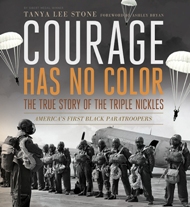2018 School Spending Survey Report
A Mission Above and Beyond Them | An Interview with Tanya Lee Stone
Author Tanya Lee Stone talked to Curriculum Connections about the importance of visual storytelling in her work "Courage Has No Color: The True Story of the Triple Nickles: America's First Black Paratroopers."
 Tanya Lee Stone's search—for photos and facts—has led her in surprising and rewarding directions. "To me, visual storytelling is as important as the text," Stone has said, and that is certainly true of Courage Has No Color: The True Story of the Triple Nickles: America's First Black Paratroopers (Candlewick, Jan. 2013). Through text and images the author paints a fascinating portrait of the African Americans who trained as part of the 555th Parachute Infantry Battalion under First Sergeant Walter Morris. Seventeen of those 20 men came from the all-black 92nd Infantry Division, whose roots could be traced back to the Buffalo Soldiers of the Revolutionary and Civil Wars. The author spoke to Curriculum Connections about her research, and the Triple Nickles’ extraordinary legacy. What attracted you to this topic? Did it have any relationship to your work on Almost Astronauts: 13 Women Who Dared to Dream (Candlewick, 2009)? These stories are related in that they are both about extraordinary people, relatively unknown individuals, whose work paved the way for others. Change happens slowly—and it’s often due to individuals such as these. We owe them tribute. When you begin a nonfiction work, do you have a sense of where you're going, or do you let the research guide you? The research did guide me, as did feedback from Marc Aronson and Hilary Van Dusen, who said, as they did with Almost Astronauts, "This story is too big for a picture book." I tend to think cinematically, so I'm looking at the story through the points-of-view of the Triple Nickles' and [their leader, First Sergeant] Walter Morris. What are the margins that inform those perspectives? That helps me shape my boundaries. Unfortunately, it took almost 10 years to write the book! You interviewed Morris, as well as a number of the women represented in Almost Astronauts. It's amazing to think that these events didn’t transpire that long ago. It wasn't that long ago. I think we have come a long way—and have a really long way to go. That's why it's important to highlight these stories. We can be proud of our achievements—and have them motivate us to do a whole lot more. Your notes on your work on the identities of the Triple Nickles who did not graduate, and how you resolved inconsistencies discovered in your research, were fascinating. That was so thrilling [figuring out the three men who hadn't graduated]! The first person I called when I made sense of that information was Ed Howard. He's the historian at Fort Benning [where those first black paratroopers trained]. After the book was finished, Ed and I kept working to track down the information that was eluding me. I found two of the men through a document that noted who was paid when. Is detective work also involved in photo research? On occasion, a photograph is in opposition to a "fact" you have unearthed earlier. You have to use your journalistic skills to figure out the truth. Even in the archives, the labels are sometimes incorrect. There’s a photo of the 761st tank battalion (the camera is looking down into the tank as a man looks up), that has been mislabeled for decades. When I got to the 761st tank battalion section, I went back to the library. In the end, I agreed with who I believed was the most trusted scholar and relabeled the photo; [in my book] the label is different than the one attributed in the National Archives. It is like being a detective. In order to be authoritative, everything must be verified. Were there events that you uncovered that surprised you? I had no idea that balloon bombs launched from Japan were landing in western states such as Oregon, for instance. I had no idea about the balloon bombs, either. I could have gone on and on about them. To include information about these weapons and to not provide background on the Japanese-American internment camps seemed wrong, [but] I also was aware that I had to balance these pieces with the rest of the story. This is complicated material and the challenge was to select what was pertinent to the paratroopers' story and would give readers the context they needed. There's an unending wealth of stories to tell. So many of the events we know of in history depend on timing—when the many small actions of people come together, as you point out. When change happens, we tend to forget that many events preceded it. There's another parallel between Almost Astronauts and Courage, in that people sometimes say to me, "But [the Triple Nickles] didn't get sent into combat" with a tone in their voice that suggests, "Why are you making such a big deal out of this?" What these men accomplished was of their time. If you're looking at it through a 21st-century lens, you miss it. Many children aren’t [aware of how the rights we enjoy now] were achieved. That's why I spend the amount of time I spend on background. With context, on their own, children can get to, "Wow, that's a big deal."
Tanya Lee Stone's search—for photos and facts—has led her in surprising and rewarding directions. "To me, visual storytelling is as important as the text," Stone has said, and that is certainly true of Courage Has No Color: The True Story of the Triple Nickles: America's First Black Paratroopers (Candlewick, Jan. 2013). Through text and images the author paints a fascinating portrait of the African Americans who trained as part of the 555th Parachute Infantry Battalion under First Sergeant Walter Morris. Seventeen of those 20 men came from the all-black 92nd Infantry Division, whose roots could be traced back to the Buffalo Soldiers of the Revolutionary and Civil Wars. The author spoke to Curriculum Connections about her research, and the Triple Nickles’ extraordinary legacy. What attracted you to this topic? Did it have any relationship to your work on Almost Astronauts: 13 Women Who Dared to Dream (Candlewick, 2009)? These stories are related in that they are both about extraordinary people, relatively unknown individuals, whose work paved the way for others. Change happens slowly—and it’s often due to individuals such as these. We owe them tribute. When you begin a nonfiction work, do you have a sense of where you're going, or do you let the research guide you? The research did guide me, as did feedback from Marc Aronson and Hilary Van Dusen, who said, as they did with Almost Astronauts, "This story is too big for a picture book." I tend to think cinematically, so I'm looking at the story through the points-of-view of the Triple Nickles' and [their leader, First Sergeant] Walter Morris. What are the margins that inform those perspectives? That helps me shape my boundaries. Unfortunately, it took almost 10 years to write the book! You interviewed Morris, as well as a number of the women represented in Almost Astronauts. It's amazing to think that these events didn’t transpire that long ago. It wasn't that long ago. I think we have come a long way—and have a really long way to go. That's why it's important to highlight these stories. We can be proud of our achievements—and have them motivate us to do a whole lot more. Your notes on your work on the identities of the Triple Nickles who did not graduate, and how you resolved inconsistencies discovered in your research, were fascinating. That was so thrilling [figuring out the three men who hadn't graduated]! The first person I called when I made sense of that information was Ed Howard. He's the historian at Fort Benning [where those first black paratroopers trained]. After the book was finished, Ed and I kept working to track down the information that was eluding me. I found two of the men through a document that noted who was paid when. Is detective work also involved in photo research? On occasion, a photograph is in opposition to a "fact" you have unearthed earlier. You have to use your journalistic skills to figure out the truth. Even in the archives, the labels are sometimes incorrect. There’s a photo of the 761st tank battalion (the camera is looking down into the tank as a man looks up), that has been mislabeled for decades. When I got to the 761st tank battalion section, I went back to the library. In the end, I agreed with who I believed was the most trusted scholar and relabeled the photo; [in my book] the label is different than the one attributed in the National Archives. It is like being a detective. In order to be authoritative, everything must be verified. Were there events that you uncovered that surprised you? I had no idea that balloon bombs launched from Japan were landing in western states such as Oregon, for instance. I had no idea about the balloon bombs, either. I could have gone on and on about them. To include information about these weapons and to not provide background on the Japanese-American internment camps seemed wrong, [but] I also was aware that I had to balance these pieces with the rest of the story. This is complicated material and the challenge was to select what was pertinent to the paratroopers' story and would give readers the context they needed. There's an unending wealth of stories to tell. So many of the events we know of in history depend on timing—when the many small actions of people come together, as you point out. When change happens, we tend to forget that many events preceded it. There's another parallel between Almost Astronauts and Courage, in that people sometimes say to me, "But [the Triple Nickles] didn't get sent into combat" with a tone in their voice that suggests, "Why are you making such a big deal out of this?" What these men accomplished was of their time. If you're looking at it through a 21st-century lens, you miss it. Many children aren’t [aware of how the rights we enjoy now] were achieved. That's why I spend the amount of time I spend on background. With context, on their own, children can get to, "Wow, that's a big deal."  Listen to Tanya Lee Stone introduce and read from Courage Has No Color.
Listen to Tanya Lee Stone introduce and read from Courage Has No Color. RELATED
RECOMMENDED
CAREERS
The job outlook in 2030: Librarians will be in demand
CAREERS
The job outlook in 2030: Librarians will be in demand
ALREADY A SUBSCRIBER? LOG IN
We are currently offering this content for free. Sign up now to activate your personal profile, where you can save articles for future viewing






Add Comment :-
Comment Policy:
Comment should not be empty !!!
BookTalk Nation — Blog
[...] an interview with School Library Journal, Tanya explained that she spends a lot of time describing her characters’ background and the [...]Posted : Mar 11, 2013 09:55